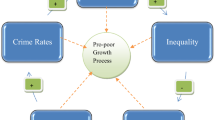Abstract
This paper uses annual pooled data over 1998–2002 for transition countries to examine whether government size or country size matters more in its impact on corruption; and whether piecemeal reforms or comprehensive transition reforms are desirable for corruption reduction. Our results show that greater economic prosperity leads to lower corruption, and contrary to findings for other nations, a bigger government size seems toreduce corruption in transition nations. The geographic size of a country is positive and significant, suggesting that more spread out countries would have a harder time controlling corruption. Comprehensive transition reforms might work best at corruption reduction.
Similar content being viewed by others
References
Abed, G.T. and H.R. Davoodi. 2000. “Corruption, Structural Reforms, and Economic Performance in the Transition Economies.”IMF Working Paper WP/00/132.
Aidt, T.S. 2003. “Economic Analysis of Corruption: A Survey.”Economic Journal 113: F632-F652
Bardhan, P. 1997. “Corruption and Development: A Review of Issues.”Journal of Economic Literature 35: 1320–1346
Becker, G.S. 1968. “Crime and Punishment: An Economic Approach.”Journal of Political Economy 76: 169–217.
Budak, J. and R.K. Goel. 2004a. “Economic Reforms and Corruption in Transition Countries.” Mimeo, Institute of Economics, Zagreb.
Budak, J. and R.K. Goel. 2004b. “Transition, Governance and Corruption.”Economia Internazionale/International Economics 57:395–406.
Eilat, Y. and C. Zinnes. 2002. “The Shadow Economy in Transition Countries: Friend or Foe? A Policy Perspective.”World Development 30: 1233–1254.
European Bank for Reconstruction and Development,Transition Report 2002, UK: London, 2002.
Fischer, S. and R. Sahay. 2000. “The Transition Economies after Ten Years.”National Bureau of Economic Research, Working Paper #7664.
Goel, R.K. and M.A. Nelson. 2005. “Economic Freedom versus Political Freedom: Cross-Country Influences on Corruption.”Australian Economic Papers 44: 121–133.
Goel, R.K. and M.A. Nelson. 1998. “Corruption and Government Size: A Disaggregated Analysis.”Public Choice 97: 107–120.
Jain, A.K. 2001. “Corruption: A Review.”Journal of Economic Surveys 15: 71–121.
Johnson, S., D. Kaufmann, and P. Zoido-Lobaton. 1998. “Regulatory Discretion and the Unofficial Economy.”American Economic Review, Paper and proceedings 88: 387–392.
Kaufmann, D., A. Kraay, and M. Mastruzzi. 2003. “Governance Matters III: Governance Indicators for 1996–2002.”World Bank Policy Research Working Paper #3106.
Kaufmann, D. and P. Siegelbaum. 1996. “Privatization and Corruption in Transition Economies.”Journal of International Affairs 50: 419–458.
Knack, S. and P. Keefer. 1995. “Institutions and Economic Performance: Cross-Country Tests Using Alternative Institutional Measures,.”Economics and Politics 7: 207–227.
Lambsdorff, J.G. 2002. “Making Corrupt Deals: Contracting in the Shadow of Law.”Journal of Economic Behavior and Organization 48: 221–241.
Lambsdorff, J.G. and S.U. Teksoz. 2005. “Corrupt Relational Contracting.” inThe New Institutional Economics of Corruption, edited by J.G. Lambsdorff, M. Taube and M. Schramm. New York: Routeledge, 138–151.
May, J.W., W. Pyle, and P.M. Sommers. 2002. “Does Governance Explain Unofficial Activity?”Applied Economics Letters 9: 537–539.
Méon, P.G. and K. Sekkat. 2005. “Does Corruption Grease or Sand the Wheels of Growth?”Public Choice 122: 69–97.
Raiser, M., M.L. Di Tomasso, and M. Weeks. 2000. “The Measurement and Determinants of Institutional Change: Evidence from Transition Economies.”European Bank for Reconstruction and Development Working Paper #60.
Ram, R. 1997. “Tropics and Economic Development: An Empirical Investigation.”World Development 25: 1443–1452.
Ramsey, J.B. and P. Schmidt. 1976. “Some Further Results on the Use of OLS and BLUS Residuals in Specification Error Tests.”Journal of the American Statistical Association 71: 389–390.
Rose-Ackerman, S. 1999.Corruption and Government. Cambridge: Cambridge University Press.
Shleifer, A. and R. W. Vishny. 1993. “Corruption.”Quarterly Journal of Economics 108: 599–617.
Tanzi, V. 1998. “Corruption around the World: Causes, Consequences, Scope and Cures.”IMF Staff Papers 45: 559–594.
Treisman, D. 2000. “The Causes of Corruption: A Cross-National Study.”Journal of Public Economics 76: 399–457.
Author information
Authors and Affiliations
Corresponding author
Rights and permissions
About this article
Cite this article
Goel, R.K., Budak, J. Corruption in transition economies: Effects of government size, country size and economic reforms. J Econ Finan 30, 240–250 (2006). https://doi.org/10.1007/BF02761489
Issue Date:
DOI: https://doi.org/10.1007/BF02761489




